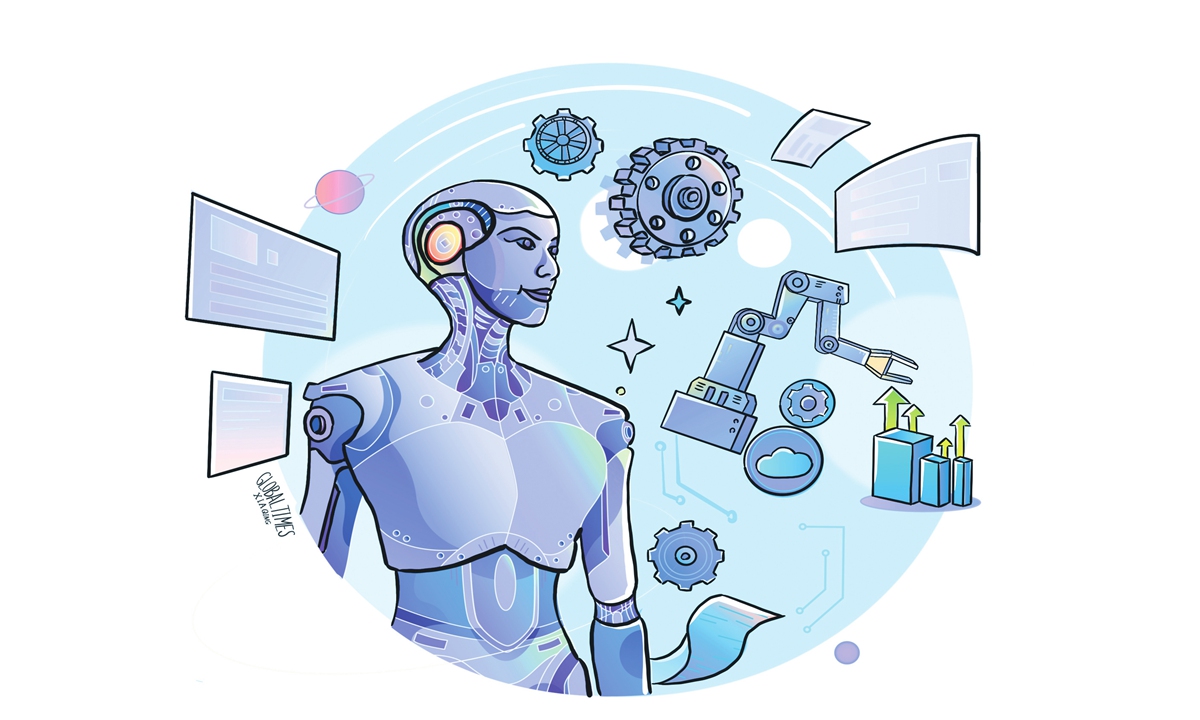China possesses distinct advantages in humanoid robot sector despite external curbs

(Illustration: Xia Qing/GT)
In recent trading sessions, stocks related to humanoid robots in China's A-share market have seen a significant surge, attracting the attention of investors. This upward momentum reflects the increasing confidence in the future potential of China's humanoid robotics sector.
Last week, a newly released video featured Optimus, Tesla's humanoid robot currently in development, catching a tennis ball and placing it down with its dexterous hands. This demonstration garnered widespread attention, sparking discussions about the future of humanoid robots and emerging business opportunities within this rapidly evolving industry.
Humanoid robots combine advanced technologies such as artificial intelligence (AI), cutting-edge manufacturing techniques, and innovative materials. Representing a bold new frontier in emerging industries, they have the potential to become transformative products that could reshape the future.
In the field of humanoid robotics, companies around the world are making significant technological advancements. In China, humanoid robots are at a pivotal stage, transitioning from the laboratory to real-world applications. The increasing interest from investors highlights the market's recognition of the vast potential for humanoid robots in China. The influx of new investments is expected to accelerate further development in the industry.
In 2023, China's Ministry of Industry and Information Technology issued a guiding opinion to promote the country's innovative development of humanoid robots, outlining key targets for 2025 and 2027.
According to the plan, by 2025, humanoid robot products will reach internationally advanced standards and enter mass production. By 2027, China aims to significantly boost its technological innovation capabilities, establishing an industry ecosystem that is globally competitive, and positioning itself at the forefront of global technological standards.
Mass production will be a key milestone in the development of China's humanoid robot industry. To foster high-quality growth in this sector, relentless efforts need to be made, including increasing investment in research and development.
China has several distinct advantages in advancing the humanoid robot industry.
Technologically, Chinese companies have made significant strides in areas such as humanoid robot motion control and human-machine co-adaptation. In certain fields, their capabilities have already reached internationally competitive levels.
From a commercialization standpoint, Chinese firms currently hold a clear edge in the key areas that drive a robot's market success: practicality, cost-effectiveness, and intelligence. These factors are crucial for ensuring widespread adoption.
Additionally, China's robust industrial ecosystem and vast consumer market provide an ideal testing ground for the development and deployment of humanoid robots. China has maintained its position as the world's largest industrial robot market for 11 consecutive years. Over the past three years, more than half of the world's new robot installations have been in China. Humanoid robots are expected to make their initial impact in the industrial sector, taking over tasks currently performed by humans. As these robots continue to evolve, their applications are likely to expand into the public sector, potentially transforming many aspects of daily life.
In recent years, China's humanoid robot industry has experienced rapid growth and made significant strides. However, there is still work to be done before the sector reaches full maturity, particularly in the development of core technologies. A key focus in this journey is the integration of AI into robotics - an area in which Chinese companies need to make breakthroughs, especially in fields like semiconductors.
At the same time, some Western nations have ramped up efforts to engage in technology "decoupling," particularly in the semiconductor industry, with the aim of slowing the progress of China's high-tech sector. This pressure is unlikely to subside but to intensify in the future. To navigate these challenges, Chinese companies need to continue prioritizing independent innovation, dismantling Western monopolies, and leveraging technological advances alongside China's well-established industrial and supply chains. This approach will be crucial for advancing high-tech manufacturing, including the development of humanoid robots.
Photos
Related Stories
- Chinese team designs robotic insect running swifter than cockroaches
- China emerges as global frontrunner in industrial robot density: report
- French doctor uses Chinese robot to perform remote cancer surgery for patient in Morocco
- Robotic dog patrols Hangzhou streets
- Robots exhibited at 26th China High-Tech Fair (CHTF) in Shenzhen
Copyright © 2024 People's Daily Online. All Rights Reserved.









